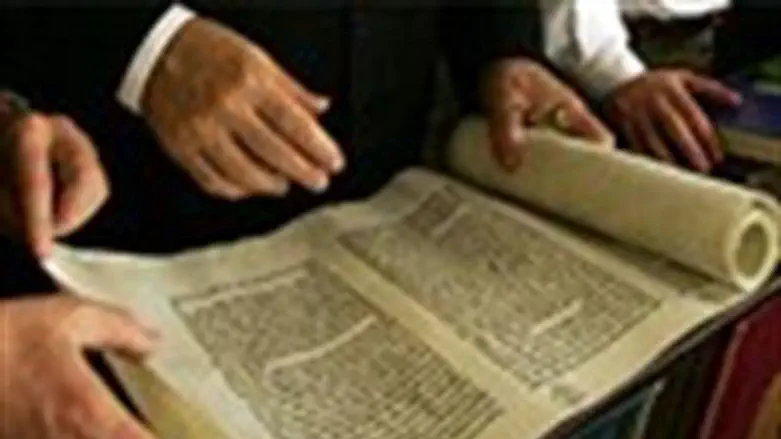
The festive holiday of Purim begins on Wednesday night, directly after the Fast of Esther, which was commemorated on Wednesday. (For thought-provoking articles on the spiritual aspects of Purim in A7's Judaism section, click here and here).
The Purim holiday for most communities will last until Thursday evening; in Jerusalem, it begins Thursday evening and ends at the start of the Sabbath on Friday. In some areas it is celebrated on both days. The criteria for the date is whether the city was walled in the times of Joshua Bin-Nun’s conquest of the Land of Israel – a standard set by the Sages in order to aggrandize the stature of the Land of Israel.
The festivities begin with the public and joyous reading of the Scroll of Esther, as the holiday commemorates the events described in the Book of Esther, to wit: After the anti-Semitic Haman, Grand Vizier of the Persian Empire, plots to destroy the Jews of the empire's 127 countries, and after the Jews then embark upon a path of repentance and spiritual self-reckoning, a series of Divinely-contrived events foils the murderous scheme and allows them to rise up and defeat their enemies.
In addition to the reading of the above Scroll, at night and the following morning, the day’s special commandments also include the giving of charity to at least two needy people, a festive meal, sharing two ready-to-eat food portions (Mishloach Manot) with at least one person, and in general being happy and thankful to G-d for His deliverance. Synagogues are filled with charity boxes for "machatzit hashekel", coins donated on Purim to remember the half shekel given to the Temple by the Jews each year to finance the daily sacrifices.
In recent years, many synagogues have taken to computerized Mishloach Manot, where congregants receive a computer list of members, mark off those to whom they wish to send Purim portions and pay a small amount per person. Each family then gets one basket of goodies. The extra funds are donated to charity, in keeping with Maimonides' assertion that it is better to give more charity to the poor than to send many food portions to friends.
This year, since they celebrate on Friday, Jerusalemites have a special problem. The festive Purim meal is normally eaten in the late afternoon and goes on into the night hours. However, one is not permitted to eat a heavy meal on Friday afternoon, so as to be hungry for the Friday night meal. To solve this problem, some families will have their meal at 11 a.m. on Friday and end early. Others will try an unusual twist: they will begin the Purim festive meal one hour before the Sabbath, take a break to cover the hallah with a cloth, light candles and say the prayers welcoming the Sabbath (Kabbalat Shabbat) at the proper time, and continue the meal afterwards as a combination Purim and Sabbath meal. Kiddush includes the blessing on wine that night only if there is a guest who did not drink wine at the Purim meal. Evening prayers are recited after dessert and Grace after Meals is said including the special inserts for Purim and the Sabbath.
The joy of Purim is often augmented by the imbibing of varying quantities of wine and other intoxicating beverages, unusual for Judaism, and a symbol of the intoxicating joy of being saved. The Sages ruled that once one can no longer distinguish (adloyada) between “Blessed is Mordechai” and “Accursed is Haman” - the two who led the forces of good and evil, respectively, in the Purim story - no further wine need be downed. Some take upon themselves the stringency of refraining from wine altogether, and fulfill the commands to be joyous and undiscriminating otherwise. (To understand the command to drink on Purim, click here.)
Costumes are often worn on Purim, especially by children, symbolizing the hidden, Divinely-"au contraire" aspects of Jewish history, in that events that appear to be leading in a negative direction can often end up in precisely the opposite place. Israel's health funds and emergency services publish warnings to parents about avoiding the purchase of flammable costumes and fireworks.
The Purim salvation seemed to be due to natural events, and G-d's name is not mentioned in the Book of Esther (commentators say that when it says "the King" without naming Ahasueros, the reference hints at G-d) but G-d's hand moves the players from behind the scenes. This "hidden" aspect of the story is symbolized in traditional Purim foods that have fillings "hidden" inside: hamantaschen, triangular pastry filled with poppy seeds or prune jam (and nowadays with anything the baker decides to try!), and in Ashkenazi tradition, stuffed cabbage and kreplach (ravioli with meat/potato filling).
Celebrating the miraculous salvation and the Jews’ return to a nationally-united, Torah way of life, Purim has traditionally symbolized the defeat of anti-Semitic tyranny and Jewish assimilation. On this happy, carnival-like holiday many offices, shops, and public institutions operate on a reduced basis. Many cities features adlyoda parades, clowns, costumes, there are lendless parties and festivals, and - in religious neighborhoods - sound trucks, people dancing from house to house and crowds of masquerading children rushing to deliver mishloach manot .
Hillel Fendel, former A7 writer, contributed to this article.